|
The
German-Czech Bead Industry
The German bead industry is still alive, but only just. It
is based out of southern Germany, in the Bavarian city of Neu
Gablonz, named, of course, after Gablonz, the Bohemian city which
was the capital of the Austrian bead industry during the Austrian
Empire, and later Czechoslovakia, when the name was changed to
Jablonec nad Nisou. The local chamber of commerce dates Jablonec
back to 1356 when it was first mentioned in documents, but permanent
settlement only occurred in the 16th century when a glass works
was established in Mseno, which is now incorporated inside the
city limits of Jablonec.
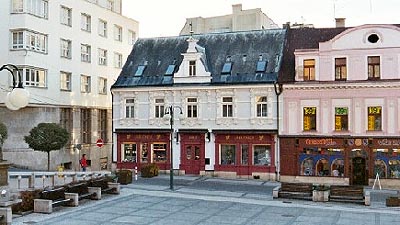 One
of the squares in the center of Jablonec. One
of the squares in the center of Jablonec.
How this all came to be starts way back in the 12th century
when early documents record German glass makers from the Rhineland
being invited to settle in the area of the Austrian-Hungarian
Empire known as Bohemia. This was a relatively unsettled province
with large forests and rivers, and sand useful for glass making.
The earliest known glass factory is outside of present day Jablonec.
It is of course just a ruin, but a museum stands on its site.
In the Jizera Mountains outside of Jablonec at Vysoka are the
ruins of another glass works, Sklenavice, which date back to
the 14th century.
By the 1700’s, chandeliers were being produced in Jablonec,
as were glass stones for the jewelry trade. The first recorded
showing at a trade show in Prague of pressed glass beads was
in 1829. By 1850, glass beads were being produced by the millions,
and exported all over the world. The owners of these bead factories
were the German glassmakers, who had invented the costume jewelry
industry, and had made a name for themselves as the finest Austrian
crystal glass producers in the world. Swarovski is one name brand
that comes to mind.
The 1930’s saw a decline, then a halt in the manufacture
of glass beads, as events leading up to World War Two overtook
the need for beads, and manufacture of ammunition and weapons
became all important, and all resources of raw materials and
people was used to this end. Not many beads were made during
this time.
At the end of the war, 1946, the Germans, known as the Suduten
Deutsch, as Germany had called that region of Bohemia Sudutenland
during their occupation of the area during the war, were expelled
from Czechoslovakia. They were given 48 hours to leave, usually
with just one suitcase of belongings. They had to leave behind
everything else they owned; their houses, their furniture, their
businesses. The Czech workers who were employed by them were
able to take over the factories, and keep them running. Whole
Czech families moved into German houses, filled with furniture
and chinaware, silverware and linens. The German refugees streamed
into war torn Germany, and most of the bead makers ultimately
settled in Bavaria, near the town of Kaufburen. In all, five
towns were settled by bead makers; Lauscha being one, as was
Neu Gablonz, Austria. Bayruth was another town. Another was Quedlinburg
in the Harz Mountains.
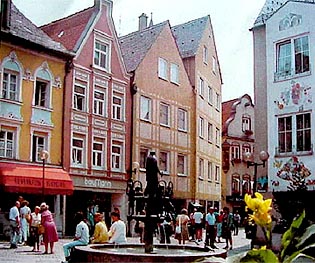 Efforts were made to keep all
the bead makers together, so the bead industry would survive,
and a bombed out ammunitions factory outside of Kaufburen was
purchased for this purpose. The town was named Neu Gablonz. Kaufburen/Neu
Gablonz is about an hours drive south of Munich on the way to
Austria. Efforts were made to keep all
the bead makers together, so the bead industry would survive,
and a bombed out ammunitions factory outside of Kaufburen was
purchased for this purpose. The town was named Neu Gablonz. Kaufburen/Neu
Gablonz is about an hours drive south of Munich on the way to
Austria.
One of the town squares in Kaufburen.
By 1947, over 2000 bead makers had settled in Neu Gablonz,
and started producing beads. Resources were so scarce, clay and
bubblegum were used as molds to create bead shapes. Some of the
bead makers did bring their molds with them, and of course some
of the refugees were mold makers. 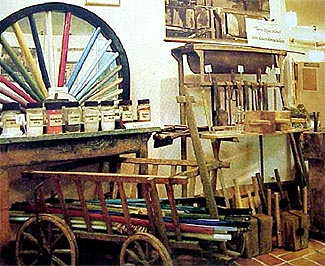
Today, these early beginnings are documented in the bead museum
in Neu Gablonz, which is located at the Gablonzer Industries
building and conference center.
Gablonzer Industries museum.
Sadly, although the bead industry is still alive, it is shrinking.
There are less than 400 factories still producing glass beads,
and most of these are small, family run operations, where the
owners are older, and the children are showing no interest in
continuing the business. Most of the glass beads being produced
are for internal consumption by the factories themselves, who
make finished jewelry for sale to the European market. Very few
are willing to sell just the raw component beads.
One such family is the Blaschke ‘s. When we first met
them, they invited us in to their house, where they had a sales
room to show off their lampwork beads. Along one wall was a show
case of beautiful beads. When asked if any were for sale, they
replied no, they were beads made by all the previous generations
of Blaschke’s that came before, their father, and his father’s,
both who had been in Gablonz. When they were young adults in
1946 they had been kicked out of Czechoslovakia, and had taken
these beads with them as examples of the beads to continue making
once they were settled in Neu Gablonz. We then asked if they
could make beads just like the museum beads in their display
case, and they said they could. We began our relationship with
them by ordering their new production beads, and by commissioning
them to remake new beads based on their grandparents designs.
The next year when we went back for more, they allowed us to
dig through a file cabinet in the back room that had job lots
of old vintage lampwork dating from their great grandparents,
grandparents, and their parents. While we were digging, we came
across the job lots of the current Blaschke production, where
he was continuing the tradition of filling up the filing cabinet
drawers with over production beads. It felt good to see history
happening right in front of us.
One sad thing about the Blaschke’s, which is mirroring
all the German bead makers, is that they are the last generation
to make beads. Their daughter is the book keeper for their business,
but does not make beads, nor has she shown any interest in making
beads. Their style of lampwork beads will die with this generation.
The Blaschke’s brother has a building next door where
he manufactures plastic beads using injection molds.
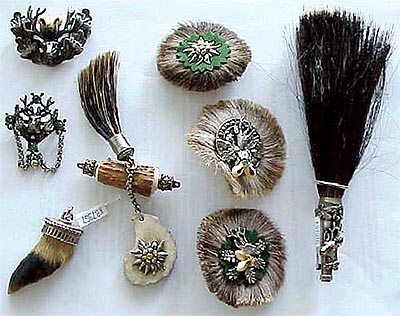 Another family whom we met and
purchase buttons from are the Schnabels. The Artur Schnabel Co.
manufactures traditional Bavarian accessories using metal parts
and eidelweiss flowers from the region. They were originally
from Gablonz, and had to leave at the end of the war with all
the other German refugees. Another family whom we met and
purchase buttons from are the Schnabels. The Artur Schnabel Co.
manufactures traditional Bavarian accessories using metal parts
and eidelweiss flowers from the region. They were originally
from Gablonz, and had to leave at the end of the war with all
the other German refugees.
A sample of the products of the
Artur Schnabel Co.
One interesting side note about the bead making community
of Neu Gablonz and the town of Kaufburen, which is right next
to it, at least from a non german standpoint, such as myself,
is that at first blush they are all Germans. But this is not
so. The inhabitants of Kaufburen have been there for centuries,
and in fact are a mixture of German and Italian, because of all
the shifting of national borders over the centuries due to wars,
etc…, (an example being the family who owns the beautiful
bed and breakfast Inn we stay at, built right into the medieval
wall of the town, the Lombardini’s.) whereas the inhabitants
of Neu Gablonz are Sudeten German, which are foreign born Germans
who have been living in Bohemia under Austian rule since 12th
century, then Nazi German rule during the war, before settling
in Neu Gablonz in 1946/47. They are foreigners to the area, and
there is a lot of conflict and turmoil going on between the two
communities.
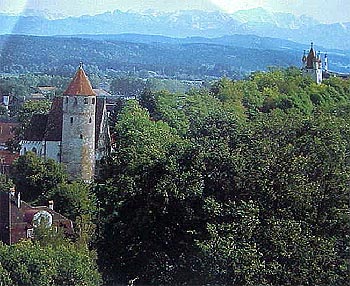 View of the town of Kaufburen
and the Tower View of the town of Kaufburen
and the Tower
where the hotel Am Turm is located.
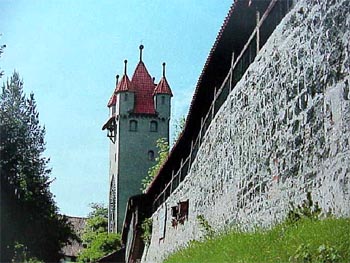
Another view of the wall that surrounds Kaufburen.
The last time we met with the Blaschke’s they took us
to dinner, and told us a little about their experiences in going
back to Jablonec for the first time in 1990, after the wall came
down following the Velvet revolution in 1989.
They had been given 48 hours to leave Czechoslovakia, with
just suitcases of belongings, and consequently had to abandon
their house and all its contents. In 1990, they were able to
go back for a visit, which they did, and when they walked up
to their house they had lived in, they noticed it was in a ruinous
state, plaster crumbling off the walls, window panes cracked
and broken, unpainted, just in terrible neglect. They knocked
on the door, and an old Czech peasant lady open it, and after
explaining who they were, and why they were there, she invited
them in for tea. They sat in their original furniture, drank
tea from their old china, and on the walls were their oil paintings
and decorations that they had been forced to leave behind. They
were just amazed, but quite happy to leave the house knowing
the Czech lady had looked after everything. They have gone back
every year since, and have become friends with the current occupant.
In America, there are only a handful of importers who offer
German beads for sale. We are one such importer. Where ever possible,
we try to use old glass made in the 1940’s, and of course
old molds. On one trip, we found a stash of old German milk glass,
dating from the 1930’s, which is a milky, opaline white,
and had fire polish beads made from it.
Another recent development because of the decline in the German
bead industry is the export to India of entire factories from
Germany – the molds, the machinery, and technicians to train
the Indian workers how to use the equipment. The only deviation
is that the Indians are still using Indian made glass, which
differentiates their beads from the original German.
One warning to unaware customers of German beads, is that
we have found that some German factories purchase Czech beads
and resell them as German beads. The most common example of this
practice is fire polish facetted beads.
Although glass bead making is a large portion of the trade
in Neu Gablonz, they also make plastic beads, buttons, crystal,
metal beads and findings, and side industries such as metallic
coatings, vacuum press technology, and faceting. Labor is expensive
in Germany, and the beads are all packaged loose. Stringing in
masses like the Czechs do is not feasible.
Although it is extremely hard to get in with a German bead
factory, it is not impossible. The first place to go to would
be the Gablonzer Industries center, in Neu Gablonz. They can
also be found on the web at www.gablonzerindustries.com . The
center houses a museum, and map of the exodus of bead makers
from Jablonec in 1946 to the different cities in Europe that
they settled in and started up business again. The center also
has a gift shop which offers for sale finished jewelry made from
the beads manufactured in Neu Gablonz. One reason that it is
so hard to buy from these factories is that they are cottage
industries, and the family business is making beads, not exporting.
So in most cases you would have to find an exporter who is familiar
with different bead makers, and who would be willing to work
with you. Unfortunately, most export agents in Kaufburen are
already affiliated with a large importer, such as John Allen,
or Alvee Rosenberg, and by using them you would not be buying
direct, but be buying through them.
Another good resource to find beads in Kaufburen/Neu Gablonz
would be antique shops. Children who have no interest in continuing
the family business are unloading the beads, tools, molds and
sample cards from their parents attics and basements into antique
shops and flea markets all the time.
Finally, if you have no luck hooking up with a factory in
Neu Gablonz, nor any luck finding beads in antique shops or flea
markets around town, then your very best shot at finding German
beads would be in Paris. And that is worthy of a whole other
article.
Good luck and happy hunting!
   |